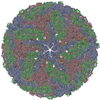登録情報 データベース : EMDB / ID : EMD-31288タイトル mature Donggang virus ウイルス : タンパク質・ペプチド : Genome polyproteinタンパク質・ペプチド : Genome polyprotein / 機能・相同性 分子機能 ドメイン・相同性 構成要素
/ / / / / / / / / / / / / / / / / / / / / / / / / / / / / / / / / / / / / / / / / / / / / / / / / / / / / / / / / / / / / / / / / / / / / / / / / / / / / / / / / / / / / / / / / / / / / / / / / / / / / / / / / 生物種 手法 / / 解像度 : 3.9 Å Zhang Y / Liang D 資金援助 Organization Grant number 国 National Natural Science Foundation of China (NSFC) 81871687
ジャーナル : Proc Natl Acad Sci U S A / 年 : 2022タイトル : Replication is the key barrier during the dual-host adaptation of mosquito-borne flaviviruses.著者 : Yanan Zhang / Dening Liang / Fei Yuan / Yiran Yan / Zuoshu Wang / Pan Liu / Qi Yu / Xing Zhang / Xiangxi Wang / Aihua Zheng / 要旨 : Mosquito-borne flaviviruses (MBFs) adapt to a dual-host transmission circle between mosquitoes and vertebrates. Dual-host affiliated insect-specific flaviviruses (dISFs), discovered from mosquitoes, ... Mosquito-borne flaviviruses (MBFs) adapt to a dual-host transmission circle between mosquitoes and vertebrates. Dual-host affiliated insect-specific flaviviruses (dISFs), discovered from mosquitoes, are phylogenetically similar to MBFs but do not infect vertebrates. Thus, dISF–MBF chimeras could be an ideal model to study the dual-host adaptation of MBFs. Using the pseudoinfectious reporter virus particle and reverse genetics systems, we found dISFs entered vertebrate cells as efficiently as the MBFs but failed to initiate replication. Exchange of the untranslational regions (UTRs) of Donggang virus (DONV), a dISF, with those from Zika virus (ZIKV) rescued DONV replication in vertebrate cells, and critical secondary RNA structures were further mapped. Essential UTR-binding host factors were screened for ZIKV replication in vertebrate cells, displaying different binding patterns. Therefore, our data demonstrate a post-entry cross-species transmission mechanism of MBFs, while UTR-host interaction is critical for dual-host adaptation. 履歴 登録 2021年5月10日 - ヘッダ(付随情報) 公開 2022年5月18日 - マップ公開 2022年5月18日 - 更新 2024年10月16日 - 現状 2024年10月16日 処理サイト : PDBj / 状態 : 公開
すべて表示 表示を減らす
 データを開く
データを開く 基本情報
基本情報
 マップデータ
マップデータ 試料
試料 キーワード
キーワード 機能・相同性情報
機能・相同性情報 Donggang virus (ウイルス)
Donggang virus (ウイルス) データ登録者
データ登録者 中国, 1件
中国, 1件  引用
引用 ジャーナル: Proc Natl Acad Sci U S A / 年: 2022
ジャーナル: Proc Natl Acad Sci U S A / 年: 2022
 構造の表示
構造の表示 ダウンロードとリンク
ダウンロードとリンク emd_31288.map.gz
emd_31288.map.gz EMDBマップデータ形式
EMDBマップデータ形式 emd-31288-v30.xml
emd-31288-v30.xml emd-31288.xml
emd-31288.xml EMDBヘッダ
EMDBヘッダ emd_31288.png
emd_31288.png emd-31288.cif.gz
emd-31288.cif.gz http://ftp.pdbj.org/pub/emdb/structures/EMD-31288
http://ftp.pdbj.org/pub/emdb/structures/EMD-31288 ftp://ftp.pdbj.org/pub/emdb/structures/EMD-31288
ftp://ftp.pdbj.org/pub/emdb/structures/EMD-31288 emd_31288_validation.pdf.gz
emd_31288_validation.pdf.gz EMDB検証レポート
EMDB検証レポート emd_31288_full_validation.pdf.gz
emd_31288_full_validation.pdf.gz emd_31288_validation.xml.gz
emd_31288_validation.xml.gz emd_31288_validation.cif.gz
emd_31288_validation.cif.gz https://ftp.pdbj.org/pub/emdb/validation_reports/EMD-31288
https://ftp.pdbj.org/pub/emdb/validation_reports/EMD-31288 ftp://ftp.pdbj.org/pub/emdb/validation_reports/EMD-31288
ftp://ftp.pdbj.org/pub/emdb/validation_reports/EMD-31288
 F&H 検索
F&H 検索 リンク
リンク EMDB (EBI/PDBe) /
EMDB (EBI/PDBe) /  EMDataResource
EMDataResource マップ
マップ ダウンロード / ファイル: emd_31288.map.gz / 形式: CCP4 / 大きさ: 421.9 MB / タイプ: IMAGE STORED AS FLOATING POINT NUMBER (4 BYTES)
ダウンロード / ファイル: emd_31288.map.gz / 形式: CCP4 / 大きさ: 421.9 MB / タイプ: IMAGE STORED AS FLOATING POINT NUMBER (4 BYTES) 試料の構成要素
試料の構成要素 Donggang virus (ウイルス)
Donggang virus (ウイルス) Donggang virus (ウイルス)
Donggang virus (ウイルス) Aedes albopictus C6/36 cell densovirus (ウイルス)
Aedes albopictus C6/36 cell densovirus (ウイルス) Donggang virus (ウイルス)
Donggang virus (ウイルス) Aedes albopictus C6/36 cell densovirus (ウイルス)
Aedes albopictus C6/36 cell densovirus (ウイルス) 解析
解析 試料調製
試料調製 電子顕微鏡法
電子顕微鏡法 FIELD EMISSION GUN
FIELD EMISSION GUN 画像解析
画像解析 ムービー
ムービー コントローラー
コントローラー







 Z (Sec.)
Z (Sec.) Y (Row.)
Y (Row.) X (Col.)
X (Col.)




















